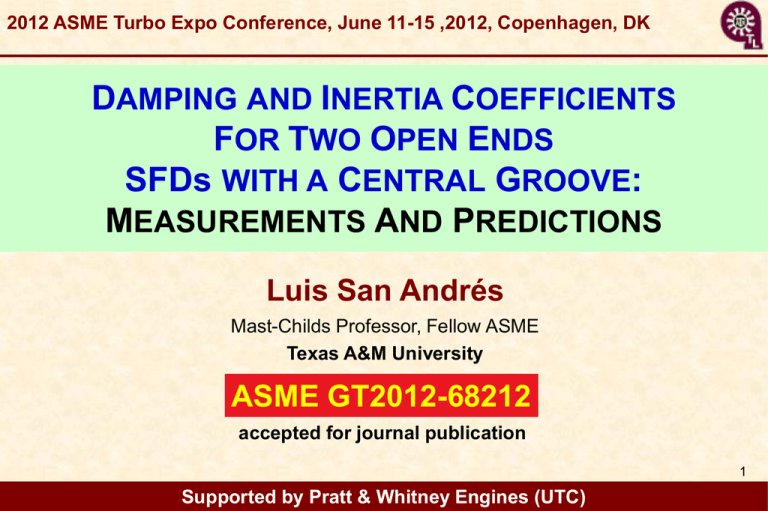GT2012-68212 - Texas A&M University
advertisement

GT2012-68212 2012 ASME Turbo Expo Conference, June 11-15 ,2012, Copenhagen, DK DAMPING AND INERTIA COEFFICIENTS FOR TWO OPEN ENDS SFDs WITH A CENTRAL GROOVE: MEASUREMENTS AND PREDICTIONS Luis San Andrés Mast-Childs Professor, Fellow ASME Texas A&M University ASME GT2012-68212 accepted for journal publication 1 Supported by Pratt & Whitney Engines (UTC) SFD operation & design GT2012-68212 In aircraft gas turbines and compressors, squeeze film dampers aid to attenuate rotor vibrations and to provide mechanical isolation. w SFD with dowel pin Y X Too little damping may not be enough to reduce vibrations. Too much damping may lock damper & degrades system rotordynamic performance 2 SFD with a central groove lubricant film anti-rotation pin shaft journal w oil inlet Feed groove ball bearing housing Conventional knowledge regards a groove is indifferent to the kinematics of journal motion, thus effectively isolating the adjacent film lands. GT2012-68212 Pressurized lubricant flows through a central groove to fill the squeeze film lands. Dynamic pressures generate fluid film reaction forces aiding to damp excessive amplitudes of rotor whirl motion. 3 P&W SFD Test Rig Isometric view GT2012-68212 Static loader Shaker assembly (Y direction) Shaker assembly (X direction) Top view Shaker in Y direction Static loader Shaker in X direction SFD test bearing 4 Test rig description shaker Y GT2012-68212 Static loader Static loader shaker X Shaker Y Shaker X Y X SFD SFD Static loader Y Y support rods Support rods base Base X X 5 SFD bearing design GT2012-68212 Geometry of open ends SFD Piston ring seal (location) Test Journal Bearing Cartridge Supply orifices (3) Circumferential groove Flexural Rod (4, 8, 12) Journal diameter: 127 mm (5.0 inch) Film clearance: 0.138mm (5 mil) Land length: 2 x 25.4 mm (2 x 1 inch) Support stiffness: 4.38 – 26.3 MN/m (25 – 150 klbf/in) Main support rod (4) Journal Base Pedestal in 6 Flow through squeeze film lands Oil inlet GT2012-68212 in ISO VG 2 oil Oil inlet temperature, Ts = 25 oC Density, ρ = 785 kg/m3 Viscosity μ at Ts= 2.96 cPoise Flow rate, Qin= 4.92 LPM 7 Objective & tasks GT2012-68212 Evaluate dynamic load performance of SFD Y with a central groove. static load e X Dynamic load measurements: circular & elliptical orbits (centered and off centered) and identification of test system and SFD force coefficients 45o c Y eS X r centered and offcentered circular orbits 8 SFD configurations tested Geometry and oil properties for open ends SFD Oil in, Qin Journal (D) GT2012-68212 Oil out, Qt End groove c L Central groove ½L L Bearing Cartridge Short SFD (B) Journal diameter, D Oil out, Qb Land length, L Oil collector Radial clearance, c Oil out Base Support rod Support stiffness range Ks = 4.4 – 26.3 MN/m (variable) Max. static load (8 kN), Max. amplitude dynamic load (2.24 kN) Range of excitation frequencies: 35 – 250 Hz Re s w c Long SFD (A) End groove = 1.1-8.3 in film lands 12.7 mm 25.4 mm CB = 0.138 mm CA = 0.141 mm Groove axial length, LG 12.7 mm Depth, dG 9.5 mm Oil wetted length, 2L + LG 38.1 mm 63.5 mm Groove static pressure, PG 0.52 bar 0.72 bar Oil inlet temperature, Ts Lubricant Density, ρ Viscosity μ at Ts Flow rate, Qin 2 127 mm 25 oC ISO VG 2 785 kg/m3 2.96 cPoise 4.92 LPM 9 Parameter Identification GT2012-68212 Y X x w 2 x a X y 2 a w y Y Journal also moves during excitation of the bearing 10 *SFDs do not have stiffnesses = reaction forces due to changes in static displacement. Parameter Identification GT2012-68212 Single frequency orbits Applied Loads Two linearly independent load vectors F1 and F2 Y 1 1 iwt F cos( w t ) F 1 X X F Re 1 e 1 FY sin(wt ) iFY FX iwt FX cos(wt ) F e Re 2 2 FY sin(wt ) iFY 2 CW X Y 2 2 CCW X x1 (t ) X 1 iwt 2 x 2 (t ) X 2 iwt z 1 1 e z 2 2 e y (t ) Y y (t ) Y 1 displacements & accelerations a1 a2 Loads F, displacement x and accelerations a recorded at each frequency 11 Parameter Identification EOMs (2 DoF) time domain EOM (Frequency Domain) GT2012-68212 M BC a+ Ms MSFD z Ks KSFD z + Cs +CSFD z F K s K SFD i w Cs + CSFD w 2 M SFD M s z FM F M BC a H z 1 z 2 FM 1 FM 2 Impedance function H(ω) Physical model H XX H HYX H XY 1 2 1 2 1 FM FM z z HYY Re( H XX ) K XX w M XX ; Im( H XX ) w CXX 2 12 Parameter Identification GT2012-68212 IVF Method* Flexibility function G(ω) IVFM solution GH 1 = transfer functions (displacement/force) Iteration on weighted least squares to minimize the estimation error in: GH=I+e SFD force coefficients (K, C, M)SFD = (K, C, M) – (K, C, M)S SFD coefficients Test system * Instrumental Variable Filter Method (IVFM) (Fritzen, 1986, J.Vib, 108) Measurement errors affect little identified parameters Support structure 13 Typ. impedances- lubricated SFD fstart Re(HXX)[MN/m] fstart 0 HXX20 40 fend fend 0 20 40 60 0 rxxre 0100 2 0.997 Rrxx 0.997 XXre 0.997 Re 100200 200300 300 Im (Hxx) Im (Hxx) 30 30 Im(HYX)[MN/m] 20 60 Real (Hxx) Real (Hxx) 20 fstart fstart rxxIm 2 0.976 0.976 rxx RXX ImIm 20 20 10 10 0 0 0 Frequency (Hz) GT2012-68212 0100 f end 0.976 100200 fend 200300 Frequency (Hz) Im(H)/w CXX [MNs/m] f start CXX40 0 40 40 fstart CXX 0 60 0 200 300 Im (Hyy) Im (Hyy) fstart fstart 20 20 10 10 0100 100200 200300 300 0 0 Short SFD eS=0; r =0.05cB 0 0100 fend fend ryyIm ryyre 0.995 ryyre 0.995 Frequency (Hz) 40 40 100 30 30 fend fend 20 20 0 20 0 20 60 Real (Hyy)Real (Hyy) fstart 20 f end 100200 300 Physical model Re(HXX)= K-w2M and Im(HXX)=Cw agree with test data. Damping C is constant over 0.954 the frequency range ryyIm 0.954 200300 300 14 SFD force coefficients - theory GT2012-68212 Centered journal (es=0), no lubricant cavitation Two film lands separated by a plenum: central groove has no effect on squeeze film forces. tanh L R D * CYY 2 12 π L 1 L c D 3 Damping * C * C XX L π LR3 tanh D 2 1 L c D Inertia * * M * M XX M YY Stiffness KXX = KYY = KXY = KYX = 0 Y X 15 GT2012-68212 Normalization of experimental coefficients SHOW ratio with respect to predictions from classical theory: C C Long damper Land length 1”, 5.55 mil C* C*A = 6.79 kN.s/m, M M M * M*A = 2.98 kg Ratio~(L/c)3~7.5 Short damper Land length 0.5” , 5.43 mil C*A = 0.92 kN.s/m, M*A = 0.39 kg Identification procedure gives NO cross-coupled coefficients for test SFDs. 16 GT2012-68212 Experimental SFD force coefficients open ends short length damper 1/2 inch lands, c=5.43 mil = 0.138 mm 0.5 inch Top Land Central groove 0.5 inch Bottom Land 17 CXX Damping coefficients SFD direct damping coefficients 6 45o 5 es = 0.29 cB 4 c es X 3 es = 0 2 1 XX SFD 0.0 Damping coefficients Y es = 0.44 cB C Damping coefficients 0 CYY GT2012-68212 vs orbit amplitude 0.2 6 0.4 0.6 0.8 1.0 es = 0.44 cB 5 4 es = 0.29 cB 3 es = 0 2 1 C Damping coefficients 0 YY SFD 0.0 0.2 0.4 0.6 0.8 1.0 CXX , CYY first decrease and then increase with orbit amplitude. Coefficients are isotropic CXX ~ CYY Orbit amplitude (r /cB) 18 Short SFD (12.7 mm lands, c=0.138 mm) SFD added mass coefficients MXX Mass coefficients 35 Y e s = 0.44 c B 30 45o 25 c e s =0.29 c B 20 15 X e s= 0 5 XX SFD 0.0 0.2 0.4 0.6 0.8 1.0 35 Mass coefficients es 10 M Coefficients Mass 0 MYY GT2012-68212 vs orbit amplitude 30 e s =0.44 c B 25 20 15 e s = 0.29 c B MXX , MYY decrease with amplitude of motion, as prior tests* and theory show** es= 0 10 5 M Mass Coefficients 0 YY SFD 0.0 0.2 0.4 0.6 0.8 1.0 Orbit amplitude (r /cB) *Design and Application of SFDs in Rotating Machinery (Zeidan, San Andrés, Vance, 1996, Turbomachinery Symposium) ** SFDs: Operation, Models and Technical Issues (San Andrés, 2010) 19 Short SFD (12.7 mm lands, c=0.138 mm) GT2012-68212 Experimental SFD force coefficients open ends long damper 1 inch lands, c=5.55 mil=0.141 mm Top Land 1.0 inch Central groove 1.0 inch 20 SFD direct damping coefficients GT2012-68212 vs static eccentricity Y All orbits (circular & elliptic) CXX Damping coefficients 45o 6 c Amplitudes of motion: 2 6 Damping coefficients X 4 0 CYY es CXXSFD 0.0 0.2 0.4 0.6 4 2 CYYSFD 0 0.0 0.2 0.4 CXX ~ CYY with amplitude of motion & orbit shape. SFD forced response is independent of BC kinematics. Static eccentricity ratio ( eS/cA) 21 Long SFD (25.4 mm lands, c=0.141 mm) SFD added mass coefficients vs staticGT2012-68212 eccentricity Y All orbits (circular & elliptic) 45o MXX Mass coefficients 12 c 10 es X 8 6 Amplitudes of motion: 4 2 M XX SFD 0 0.0 0.2 0.4 0.6 MYY Mass coefficients 12 Added Mass Coefficients 10 MXX ~ MYY not strong function of amplitude of motion or orbital shape & increasing with static eccentricity 8 6 4 2 M YY SFD 0 0.0 0.2 0.4 0.6 Static eccentricity ratio ( e S /c A ) Added Mass Coefficients 22 Long SFD (25.4 mm lands, c=0.141 mm) GT2012-68212 Recorded dynamic pressures in groove and film lands 1.0 “ 23 Dynamic pressures Piezoelectric pressure sensor (PCB) locations GT2012-68212 Side view: Sensors located at middle plane of film lands Bearing Cartridge PCB groove Mid-plane PCB top land PCB bottom land Piezoelectric sensors: 2 in the top land, 2 in the bottom land 24 2 in the groove Dynamic pressures: films & groove GT2012-68212 Whirl frequency 130 Hz Pressures film lands film atlands pressure (psi) psi 10 0.69 bar 5 0 0 5 10 -0.69 bar 0 1 2 3 Top and bottom film lands show similar pressures. 4 time (-) of periods Number top land (120 deg) bottom land (120 deg) Pressuresgroove at central groove pressure (psi) psi 4 0.28 bar 2 0 0 2 4 0 1 2 3 4 Dynamic pressure in the groove is not zero! -0.28 bar Number of periods time (-) groove (165 deg) groove (285 deg) 1.0 “ Long SFD. es=0, r=0.1cA. PG = 0.72 bar 25 Dynamic pressures: films & groove GT2012-68212 Whirl frequency 200 Hz filmat film lands Pressures lands pressure (psi) psi 10 0.69 bar 5 0 0 5 10 -0.69 bar 0 1 2 3 4 Number time of time (-) periods top land (120 deg) bottom land (120 deg) Number of time periods groove Pressures at central groove pressure (psi) psi 0.69 bar 10 0 0 10 20 Film and groove dynamic pressures increase with excitation frequency. -1.40 bar 0 1 2 3 Pressure waves show spikes (high frequency content), typical of air ingestion & entrapment 4 (-) periods Numbertime of time groove (165 deg) groove (285 deg) 1.0 “ Long SFD. es=0, r=0.1cA. PG = 0.72 bar 26 P-Ppressure pressure (psi) (psi) P-P dynamic peak-peak pressures Peak-peak dynamic pressures Top land (120) Bottom land (120) Groove (165) 40 40 2.8 bar Top land 30 (120o) GT2012-68212 Piezoelectric pressure sensor (PCB) location Bearing Cartridge 2.1 bar groove 20 top land bottom land Bottom land (120o) 10 0 1.4 bar Groove (165o) 0.7 bar 0.0 bar 0 100 200 Frequency [Hz] (Hz) Frequency (Hz) Frequency Mid-plane Groove pressures are as large as in the film lands. At the highest whirl frequency, groove pressure > 50% film land pressures 27 Ratio of groove/film land pressures GT2012-68212 peak-peak pressures Top land (120) Top land (240) Groove generates large hydrodynamic pressures! groove lands (top) 3 P-P pressure (psi) P-P pressure ratios 4 2 1 0 0 1.0 0 100 100 200 200 frequency (Hz) c=5.5 mil (0.141 mm) 3/8”~70 c Frequency (Hz) 1“ 0.5” 1” 28 GT2012-68212 Comparisons to predictions from a modern model 29 Model SFD with a central groove SFD geometry and nomenclature Use effective depth d= Xc Lubricant in Bearing orifice Lubricant in do dG groove GT2012-68212 L c : clearance LG film land recirculation zone End seal Lubricant out separation line streamline d Journal z D, diameter Effective groove depth Lubricant out Solve modified Reynolds equation (with fluid inertia) 3 P h R R 2 3 P h h 2 h h 12 2 z z t t 30 * San Andrés, Delgado, 2011, GT2011-45274. Damping Coefficients (Short SFD) Damping coefficients 10 Short SFD Short SFD, dη = 2.8cB Predicted coefficients agree well with test data. CXX (prediction) 8 GT2012-68212 CXX (test data) 6 Damping coefficients increase moderately with static eccentricity 4 2 0 0.0 CYY (prediction) CYY (test data) 0.1 0.2 Test coefficients are ~ isotropic, but predicted are unequal, CXX > CYY 0.3 0.4 Static eccentricity ratio (es / cB) circular orbits r/c = 0.1 0.5 0.6 Test coefficients are ~ 4-6 larger than simplified formulas 31 Inertia coefficients Inertia Coefficients (Short SFD) 40 M YY Short SFD M (test data) XX GT2012-68212 Predictions match well the test data. (prediction) 30 20 M YY (prediction) Inertia coefficients increase moderately with static eccentricity. MXX (test data) 10 Predicted MXX > MYY Short SFD, dη = 2.8cB 0 0.0 0.1 0.2 0.3 0.4 Static eccentricity ratio (es / cB) circular orbits r/c = 0.1 0.5 0.6 Test coefficients are ~ 20-30 larger than simplified formulas 32 Damping Coefficients (Long SFD) Damping coefficients 10 Long SFD GT2012-68212 Predicted coefficients agree well with test data. Long SFD, dη = 1.6cA CXX(prediction) 8 6 Damping coefficients increase more rapidly for the long damper. C (test data) XX 4 2 CYY(prediction) CYY(test data) 0 0.0 0.1 The test and predicted coefficients are not very sensitive to static eccentricity (es). 0.2 0.3 0.4 Static eccentricity ratio (es / cA) circular orbits r/c = 0.1 0.5 0.6 Test coefficients are ~ 3-4 larger than simplified formulas 33 Inertia coefficients Long SFD Inertia coefficients are underpredicted Inertia Coefficients (Long SFD) 12 MYY (test data) 10 MXX (test data) Coefficients grow moer rapidly with static eccentricity than in short damper. 8 6 MYY (prediction) MXX (prediction) Tests and predicted force coefficients are not sensitive to static eccentricity (es) 4 2 GT2012-68212 Long SFD, dη = 1.6cA 0 0.0 0.1 0.2 0.3 0.4 Static eccentricity ratio (es / cA) circular orbits r/c = 0.1 0.5 0.6 Test coefficients are ~ 8-10 larger than simplified formulas 34 Conclusions GT2012-68212 For both dampers and most test conditions: crosscoupled damping and inertia force coefficients are small. SFD force coefficients are more a function of static eccentricity than amplitude of whirl. Coefficients change little with ellipticity of orbit. Long damper has ~ 7 times more damping than short length damper. Inertia coefficients are two times larger. •Predictions from modern predictive tool agree well with the test force coefficients. 35 Conclusions & update GT2012-68212 • Central grove is NOT a zone of constant pressure: dynamic pressures as large as in film lands. • Classical theory predicts too low damping & inertias: 1/7 of test values More work conducted with both dampers (short and long) with • SEALED ends (piston rings) • with larger clearances (2c) • 0-1-2 orifices plugged (3-2-1 holes active) will be reported at a later date. Current damper installation has NO central groove. 36 Acknowledgments Thanks to GT2012-68212 • Pratt & Whitney Engines • students Sanjeev Seshaghiri, Paola Mahecha, Shraddha Sangelkar, Adolfo Delgado, Sung-Hwa Jeung, Sara Froneberger, Logan Havel, James Law. Questions (?) Learn more at http://rotorlab.tamu.edu 37 Relevant Past Work GT2012-68212 • Della Pietra and Adilleta, 2002, The Squeeze Film Damper over Four Decades of Investigations. Part I: Characteristics and Operating Features, Shock Vib. Dig, (2002), 34(1), pp. 3-26, Part II: Rotordynamic Analyses with Rigid and Flexible Rotors, Shock Vib. Dig., (2002), 34(2), pp. 97-126. • Zeidan, F., L. San Andrés, and J. Vance, 1996, "Design and Application of Squeeze Film Dampers in Rotating Machinery," Proceedings of the 25th Turbomachinery Symposium, Turbomachinery Laboratory, Texas A&M University, September, pp. 169-188. • Zeidan, F., 1995, "Application of Squeeze Film Dampers", Turbomachinery International, Vol. 11, September/October, pp. 50-53. • Vance, J., 1988, "Rotordynamics of Turbomachinery," John Wiley and Sons, New York Parameter identification: • Tiwari, R., Lees, A.W., Friswell, M.I. 2004. “Identification of Dynamic Bearing Parameters: A Review,” The Shock and Vibration Digest, 36, pp. 99-124. 38 TAMU references SFDs GT2012-68212 2011 San Andrés, L., and Delgado, A., “A Novel Bulk-Flow Model for Improved Predictions of Force Coefficients in Grooved Oil Seals Operating Eccentrically,” ASME Paper GT2011-45274 2010 Delgado, A., and San Andrés, L., 2010, “A Model for Improved Prediction of Force Coefficients in Grooved Squeeze Film Dampers and Grooved Oil Seal Rings”, ASME Journal of Tribology Vol. 132 Delgado, D., and San Andrés, L., 2010, “Identification of Squeeze Film Damper Force Coefficients from Multiple-Frequency, NonCircular Journal Motions,” ASME J. Eng. Gas Turbines Power, Vol. 132 (April), p. 042501 (ASME Paper No. GT2009-59175) 2009 Delgado, A., and San Andrés, L., 2009, “Nonlinear Identification of Mechanical Parameters on a Squeeze Film Damper with Integral Mechanical Seal,” ASME Journal of Engineering for Gas Turbines and Power, Vol. 131 (4), pp. 042504 (ASME Paper GT200850528) 2003 San Andrés, L., and S. Diaz, 2003, “Flow Visualization and Forces from a Squeeze Film Damper with Natural Air Entrainment,” ASME Journal of Tribology, Vol. 125, 2, pp. 325-333 2001 Diaz, S., and L. San Andrés, 2001, "Air Entrainment Versus Lubricant Vaporization in Squeeze Film Dampers: An Experimental Assessment of their Fundamental Differences,” ASME Journal of Gas Turbines and Power, Vol. 123 (4), pp. 871-877 2000 Tao, L., S. Diaz, L. San Andrés, and K.R. Rajagopal, 2000, "Analysis of Squeeze Film Dampers Operating with Bubbly Lubricants" ASME Journal of Tribology, Vol. 122, 1, pp. 205-210 1997 Arauz, G., and L. San Andrés, 1997 "Experimental Force Response of a Grooved Squeeze Film Damper," Tribology International, Vol. 30, 1, pp. 77-86 1996 San Andrés, L., 1996, "Theoretical and Experimental Comparisons for Damping Coefficients of a Short Length Open-End Squeeze 39 Film Damper," ASME Journal of Engineering for Gas Turbines and Power, Vol. 118, 4, pp. 810-815 Select effective groove depth GT2012-68212 Predictions overlaid with test data to estimate effective groove depth Short SFD Long SFD 5 8 6 4 test data 2 Predictions 0 1c dη = 2.8cB 10 c Groove depth (dη) dη = 2.8 cB 100 c Damping coefficients Damping coefficients 10 4 3 test data 2 Predictions 1 0 1 c dη = 1.6cA 10 c 100 c Groove depth (dη) dη = 1.6 cA 40






